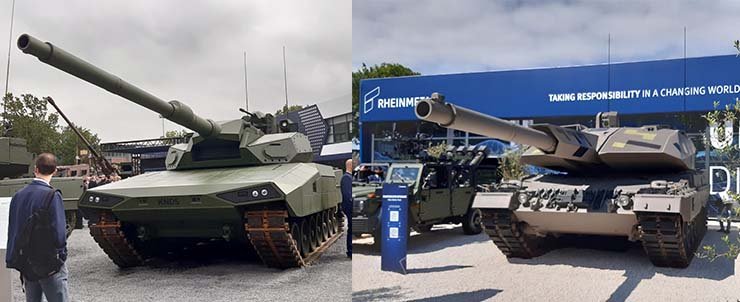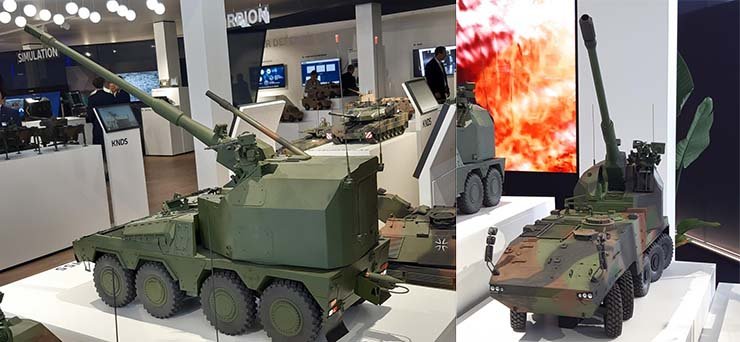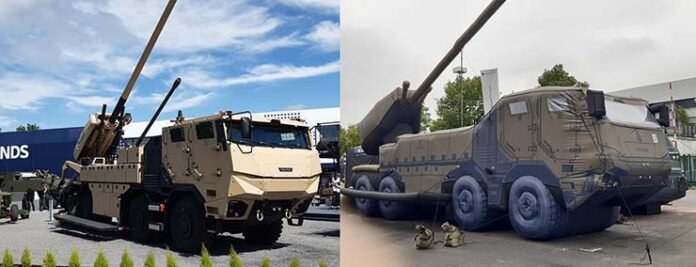With some 2,000 exhibitors and 63,000 visitors in 2024, Eurosatory reached a new milestone in confirming its status as one of the world’s most popular land and air-land defence and security industry event for experts and professionals alike. The highly successful 2024 edition was strongly influenced by the prevailing trends driven by the global climate of high-intensity warfare.
In fact, the current relevance of this issue was evident even before the exhibition began, highlighted by the political and legal controversy surrounding Israeli companies’ participation. In late May, as a protest against IDF operations in Rafah, the French government instructed Coges, the exhibition’s organiser, to prohibit Israeli companies from attending the exhibition.
By mid-June, following appeals from pro-Palestinian groups, a court ruled that employees of Israeli manufacturers should also be excluded from attending the event. Later, during the event, a court of appeal and a commercial court overturned this decision and lifted the government ban, notably on grounds of discrimination.
The exhibition encouraged operational discussions focused on the new challenges highlighted by the Ukraine conflict. Of particular note were the diverse offerings aimed at addressing the most salient lessons learned from this on-going conflict
The case is still pending, but banning such heavyweights from the defence sector caused quite a stir on the international scene. There will likely be significant financial and legal ramifications to navigate, as the excluded parties may seek compensation for incurred costs, including expenses related to the equipment already transported for display. Additionally, they may pursue claims for potentially lost business opportunities resulting from their exclusion.
However, this tragi-comic sequence, which underscores how current geopolitical events can directly impact technical-commercial events, did not overshadow the overarching theme of the Russian-Ukrainian conflict shaping global land defence capabilities.
The exhibition vividly illustrated this, and featured extensive technical and operational discussions focused on the new challenges highlighted by the Ukraine conflict. Of particular note were the diverse offerings aimed at addressing the most salient lessons learned from this on-going conflict. While it’s impossible to cover all aspects comprehensively, we will touch on a few key areas that best exemplify this trend.

Artillery: Queen of Battles
The truck-mounted 155 mm Caesar howitzer developed by Nexter, the French subsidiary of KNDS, was once again a hit, building on the reputation it has acquired among Ukrainian artillerymen – and, so it has been suggested, among their Russian adversaries.
This was notably thanks to the increased survivability provided by its mobility, and also because the fire control systems provide the capability to distribute artillery fire across the terrain while maintaining precision that far surpasses Russian artillery capabilities.
These capabilities are further enhanced in the 6×6 MkII version, on offer at the exhibition, with an enhanced armoured cab, more than double the engine power (460 hp for the new version) and even faster battery entry and exit – a key factor in avoiding counter-battery fire and loitering ammunition.
60 orders have already been placed: 36 by Armenia, 12 by Croatia (purchase intention at this stage), and 12 ordered by Estonia, which complements the existing Baltic setup that already includes 18 pieces for Lithuania, thus optimising the interoperability of gunners in this particularly sensitive zone on the NATO borders facing Russia.
The orders are expected to be fulfilled at a high rate: half of the Estonian order is expected to be delivered before the end of the year, thanks in particular to the recent tripling of production capacity.
While a few other long-range artillery capabilities were showcased, such as the new GMARS demonstrator from Rheinmetall and Lockheed, notable for its firepower, the majority of the artillery offerings were more physically understated in comparison
While a few other long-range artillery capabilities were showcased, such as the new GMARS demonstrator from Rheinmetall and Lockheed, notable for its firepower purportedly double that of the M142 HIMARS, the majority of the artillery offerings were more physically understated in comparison.
Its more mature German-Israeli competitor, the EuroPuls, for example, was not on show. Despite this, KMW from Germany continued to push forward with the promising RCH155, which is still in the development phase.
Many countries showed keen interest driven by the imperative to modernise their outdated artillery fleets or replenish those significantly depleted by contributions to Ukraine.
Informal discussions between professionals and observers suggest that the German manufacturer is confident of Canada’s potential interest in the RCH, as part of its Indirect Fire Modernisation (IFM) programme, possibly in collaboration with GD on the 10×10 Piranha chassis, especially as a Canadian delegation was present at firing tests in Switzerland recently.
The manufacturer’s testing of this version sparked discussions about the capability of the 8×8 Boxer version, to withstand the burden of a fully automated turret. Alongside early talks on Canada’s deep-fire programme for 2030, confidential discussions could hint at operational urgencies Canada seeks to address as early as 2025.
This urgency is tied to fulfilling NATO responsibilities, particularly in supporting the Enhanced Forward Presence (e-FP) Battle Group stationed in Latvia.

Drones and anti-drone technology
The conflict in Eastern Europe has served as a wake-up call for most European armies, revealing significant gaps in concepts and preparedness for modern warfare. The trauma of witnessing advanced equipment donated to Ukraine destroyed by Russian Lancet-type loitering munitions underscored the rapid evolution in warfare tactics and technology.
These munitions were developed in response to early challenges faced by Russian forces, particularly from innovative Ukrainian technological initiatives. The result was devastating losses of armoured vehicles, highlighting the urgent need for European armies to adapt and innovate in the face of evolving threats.
In concrete terms, this translated at Eurosatory into dozens, if not hundreds, of offers for unmanned vehicles of all sizes, piloting/guidance modes, propulsion, altitude of use and payloads, with a particular interest in remotely operated munitions, either as intrinsic weapons systems or integrated into other systems, such as the MTO Warbler mounted on Safran’s Patroller UAV.
Faced with a plethora of products on offer, military officials and procurement agencies tried to choose wisely, preferring to work with manufacturers offering scalable systems incorporating interchangeable modules to suit specific missions, as new technologies mature.
Anti-drone warfare has in some ways taken over from anti-IED warfare, as the focus of research. A host of initiatives, combining early detection, neutralisation by direct fire, jamming or even decoying signals between pilot and drone, or between drone and satellite guidance, have been launched
For the armed forces, this means economies of scale in terms of ownership, training and maintenance costs, as well as greater operational flexibility.
In response to this threat, anti-drone warfare has in some ways taken over from anti-IED warfare, as the focus of research. A host of initiatives, combining early detection, right down to the level of the individual combatant, and neutralisation by direct fire, jamming or even decoying signals between pilot and drone, or between drone and satellite guidance, have been launched.
Anecdotally, to evade fire, whether from artillery or loitering munitions, and more generally to help mislead the adversary on tactical intentions and layouts, the show featured some companies offering inflatable tactical decoys, such as the Czech company Inflatech and its MLRS.
This, in addition to replicating the original device’s dimensions, enables the reproduction of its thermal, radar, or electromagnetic signature, and short-range moves.

Mine countermeasures
Another significant operational challenge that has refocused Western armies is the threat posed by mines, particularly their defensive advantages highlighted by Russian actions such as the destruction of Leopard 2 tanks and Bradley vehicles halted by the Sourovikine fortification line.
To address this, a range of solutions have been proposed, with a strong emphasis on unmanned systems. These solutions encompass mine clearance, laying operations, and detection capabilities.
Advanced technologies include radars capable of penetrating tens of centimetres into the ground, coupled with artificial intelligence algorithms to accurately identify detected objects.
Among the notable offerings, British solutions from Pearson Engineering were prominent. Meanwhile, Germany was actively represented with diverse approaches.
This included Rheinmetall’s Keiler, a heavily armoured vehicle supporting mobility in a relatively conventional manner.

Additionally, in the realm of counter-mobility, the Skorpion 2 system from KNDS and Dynamit Nobel stood out. This system combines the Skorpion 2 dispersible anti-tank mine launcher with Milrem’s Type X tracked vehicle (RCV) and Dynamit Nobel’s AT2+ mine, capable of deploying 400 mines within ten minutes.
Despite the high loss rates experienced by MBTs on the Ukrainian front, as discussed earlier, there is a renewed enthusiasm evident in the diverse array of offerings, particularly from German manufacturers, notably with the future Main Ground Combat System (MGCS) in focus.
Concurrently, artillery has reaffirmed its pivotal role as the “queen of battles” reclaiming prominence through extensive and impactful deployment witnessed on both sides in Ukraine.
From Canada to France, via Ukraine, this 2024 edition was symbolic of the return of high intensity warfare as a major preoccupation of defence staffs and manufacturers, with solutions revisited in the backdrop of of ubiquitous drones and artificial intelligence.
–The writer is a defence and security industry consultant having varied experience working with medium and large companies majorly in European market. The views expressed are of the writer and do not necessarily reflect the views of Raksha Anirveda
–The writer is a defence and security industry consultant with varied experience of working with medium and large companies majorly in European market. The views expressed are of the writer and do not necessarily reflect the views of Raksha Anirveda





